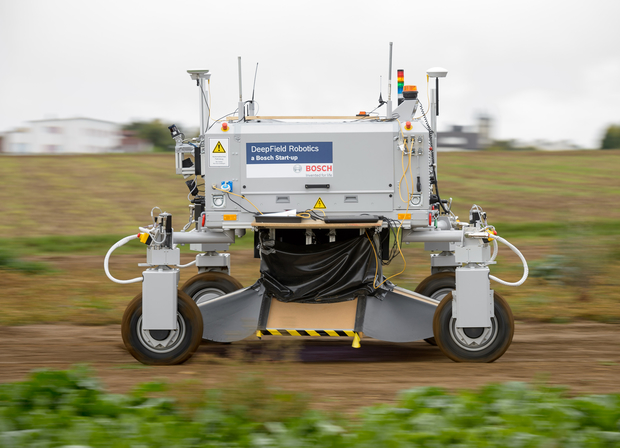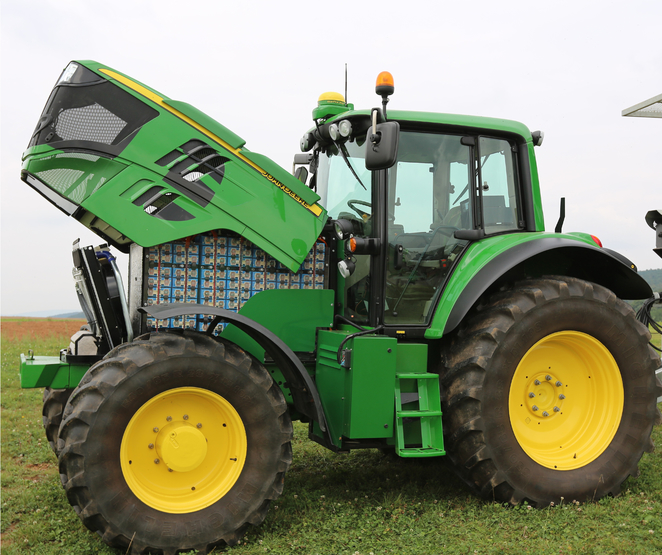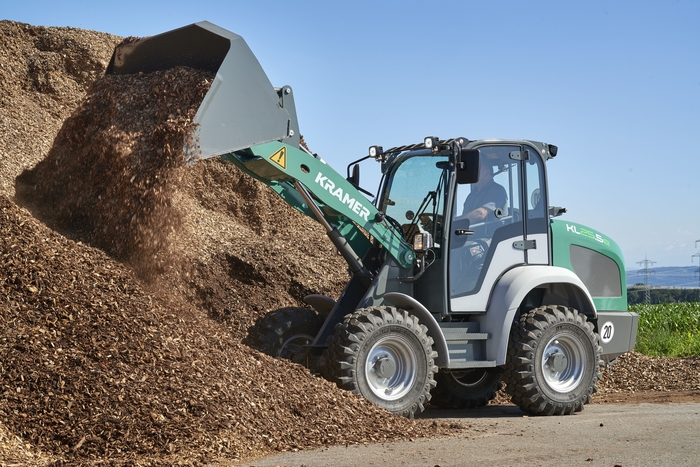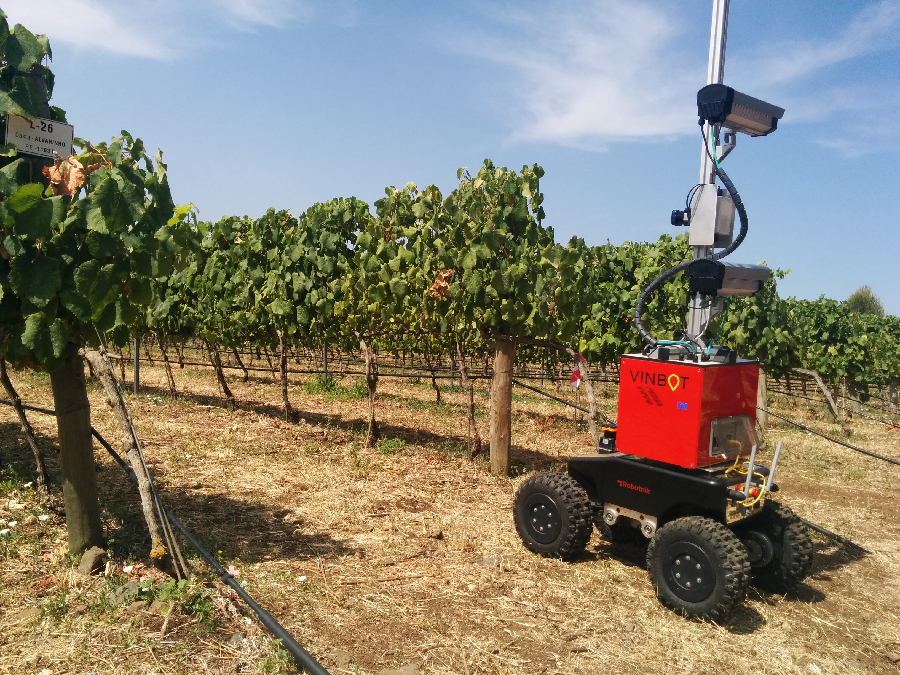
Robohub.org
Farming (r)evolution

The Bonirob agribot uses video- and laser-based positioning as well as satellite navigation to find its way around the fields and with cameras and computer-based image analysis, it recognizes and classifies plants (Bosch Deepfield Robotics).
This article was originally published on IEC e-Tech. Click here to view the original post.
Many advances in electric self‑driving car technology and robotics are transferring across to industrial and commercial vehicles, which account for some 60% of the value of the overall electric vehicle market.
In agriculture, the widening use over the next decade of autonomous hybrid or fully electric tractors, robotic machinery and drones could increase farm efficiency and revolutionize how food is produced.
Although some of the technology in farming robots is similar to that of autonomous vehicles, it differs in that operations such as planting seeds, picking vegetables or fruits and localized application of pesticides have individual sensing, manipulation and processing requirements.
Factors promoting the take‑up of agricultural robotics include the promise of increased productivity and efficiency, falling costs of self‑driving technology, reduced availability and rising costs of farm labour and the need to produce more food for a growing global population while crop yields fall in many regions as a result of climate change.
Tractors in transition to electric propulsion
Self‑driving kits, allowing tractors with GPS assistance to follow pre‑programmed routes on large farms, became available some 20 years ago. Nowadays most high‑end tractors are equipped with driverless technology, which is also compatible with combine harvesters. Using GPS, operators can guide tractors and combines to within 30 cm of any plotted location, resulting in more rows in fields and increasing productivity per acre/hectare. More than 300 000 tractors equipped with auto‑steer or tractor guidance were sold in 2016, according to market research company IDTechEx.
Leading European and US agricultural machinery companies have launched prototypes of fully autonomous cabless and driverless tractors fitted with GPS‑guided steering and sensors including radar, laser and Light Imaging, Detection and Ranging (Lidar). The raw sensor data can be used to create an accurate terrain map of both indoor and outdoor environments, while onboard video cameras enhance safety by detecting and avoiding stationary or moving obstacles. Autonomous tractors can also work with other manned machinery.
The standardization work of numerous IEC Technical Committee (TCs) and Subcommittees (SCs) contributes significantly to the performance of cameras and sensing technology used in driverless tractors and other autonomous agricultural machinery. International Standards prepared by IEC TC 47: Semiconductor devices, IEC SC 47E: Discrete semiconductor devices, and IEC SC 47F: Microelectromechanical systems, enable manufacturers to build more reliable and efficient sensors and microelectromechanical systems (MEMS). IEC TC 56: Dependability, covers the reliability of electronic components and equipment.

John Deere has unveiled its new project, the first fully-electric tractor SESAM, or Sustainable Energy Supply for Agricultural Machinery, at the Paris International Agribusiness Show in early 2017 (Photo: John Deere).
The technology for driverless agricultural machinery will allow 24‑hour autonomous operations such as seeding, planting and tillage to take place. It can enable farmers to address concerns about shortages of agricultural labour, while also increasing productivity and efficiency. IDTechEx notes that delays in the large‑scale market introduction of unmanned autonomous tractors are attributable primarily to regulation, high sensor costs and a lack of trust on the part of farmers, not too technical issues.
Tractors are also making the transition to electric propulsion. A prototype fully‑electric tractor unveiled by a leading US manufacturer earlier this year is equipped with two independent 150 kW electric motors for a total power output of up to 300 kW (402 hp). It is powered by a 130 kWh battery pack and can run for four hours on a three-hour charge.
In the transitional stage to fully‑electric tractors, kits are available to transform diesel‑engine machines into diesel‑electric tractors fitted with generators. In addition, a drivetrain that replaces the transmission, differential and axles with four electric wheel motors provides precise control of the drive tyres.
The range of commercially-available electrically‑powered agricultural vehicles extends beyond tractors to self‑propelled feed mixers and wheeled loaders, all with zero emissions, minimal noise and smooth driving characteristics.
Several IEC TCs and SCs draw up International Standards for the electronic systems, sensors, motors and batteries used in the driverless technology found in electric‑powered autonomous vehicles.
IEC TC 69: Electric road vehicles and electric industrial trucks, prepares Standards for motors and motor controllers, onboard electrical energy storage systems, power supplies and chargers.

Kramer launched the first all-wheel-steered fully electric wheel loader in January 2017 (Photo: Kramer).
Since energy for many smaller agricultural robotic vehicles is often supplied by batteries, TC 69 liaises closely with IEC TC 21: Secondary cells and batteries, and its SCs, which prepare International Standards for all secondary cells and batteries. They cover the safety installation principles, performance, dimensions and labelling of the batteries used in electric vehicles. These batteries can be of a number of different technology types including lead-acid, lithium-ion, nickel metal hydride and lithium iron phosphate.
Although electric tractors require far more power than electric cars, by the time they come into commercial production – in about five years – the size, lasting power and cost of tractor batteries should all have improved.
Diesel‑electric hybrid and battery‑electric tractors could be available on British farms as early as 2020, according to a February 2017 report by the UK National Farmers’ Union. The report envisages that, in the near future, autonomous and traditional machines will be used in partnership with one another, and electric agricultural vehicles – some autonomous, some conventional – will be charged using solar power as well as from mains connections.
Small agribots enable precision farming
While large tractors are efficient on larger farms, small electric‑powered mobile robots offer better opportunities for improving productivity on small and medium‑sized farms, says Professor Simon Blackmore, Director of the National Centre for Precision Farming (NCPF) and Head of Engineering at Harper Adams University in the UK. “In 20 years, robotics will have revolutionized agriculture”, he predicts.

Source: vinbot.eu
Automatic and robotic vehicles and mobile devices are already used for seeding, planting and tillage, picking and harvesting, weeding, sorting and packaging and even for pruning vines. A few strawberry harvesters are being trialled commercially, while robotic harvesting of apples is in the late stages of prototyping.
These lightweight agricultural robots (agribots) are capable of working day and night and in poor weather. They can also collect and transmit real-time data on the state of fields and crops, find diseases or parasites and spray pesticides.
Typically, agribots are based on some form of robotic tractor implement platform, wheeled or belt‑driven, and many are powered by electric batteries, motors and drivetrains.
Depending on the robot’s function, on‑board sensors may include biological (including chemical and gas analyzers), water, meteorological, soil respiration or moisture, photosynthesis or Leaf Area Index (LAI) sensors, as well as weed detectors, dendrometers and hygrometers. Other components range from cameras and wireless communications to robotic arms, lights for night‑time operation and solar panels to recharge batteries.
The rise in the use of robotics, together with the growth of precision agriculture, means that many farming practices will change radically. In precision agriculture, “farm data maps together with GPS‑enabled equipment have enabled variable‑rate farming technology, allowing farmers to vary the rate of input application based on the needs of specific sites/patches as opposed to the entire farm”, according to a 2016 report by IDTechEx.
For example, sensors can detect weeds and other forms of stress, enabling a robot to spray only the area affected by the parasite rather than the entire crop.
Before the end of 2017, a Japanese company in Kyoto prefecture plans to open what it describes as the world’s first farm run almost entirely by robots, producing 30 000 heads of lettuce a day. Robots will be involved in every stage of growth from delivering lettuce seedlings, trimming and watering to harvesting and delivering the fully grown produce to the packaging line. The company estimates that using robots will reduce its running costs by around 30%.
In the future, smaller tractors and robots could work together in “swarms” through a cloud‑based approach and provide multiple services, ranging from weeding, planting and applying fertilizer to harvesting and packaging food.
The Mobile Agricultural Robot Swarms (MARS) project, sponsored by the European Union (EU), is developing swarms of small, autonomous robots that can seed fields on their own. The robots are battery‑powered with electric drive mechanisms and are controlled through cloud-based digital technology. The exact placement of each individual seed can be documented and saved in the cloud, with the data used later to carry out cultivation or herbicide application with great precision.
The use of small, mobile agribots also helps to reduce the heavy soil compaction and high energy consumption usually associated with heavy machinery.
IEC standards support multi-billion dollar industry
IDTechEx reported in September 2016 that agricultural robotics already represent a USD 3 billion industry, which will grow to USD 12 billion in 2026. “Tractor‑pulled robotic implements and autonomous robotic de‑weeders will play a substantial part in that growth”, the report adds.
Earlier this year, the Dublin‑based firm Research and Markets predicted there would be even bigger sales of agricultural robots over the next decade, saying that the global market would grow at a Compound Annual Growth Rate (CAGR) of around 11,9% over the next decade to reach approximately USD 28,6 billion by 2025.
IEC standardization work from many IEC TCs and SCs supports this fast‑growing multi-billion dollar industry, with Europe, North America, Australia and New Zealand among the biggest adopters of these technologies.
tags: Environment-Agriculture, farming, opinion, robot, Service Professional Field Robotics Agriculture




